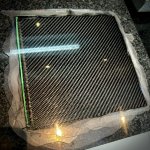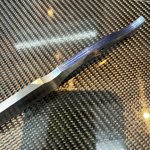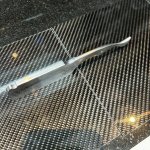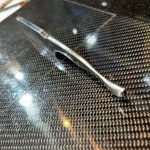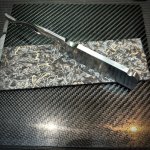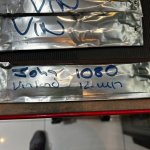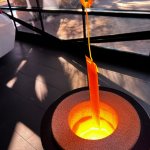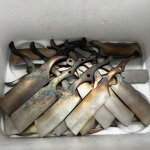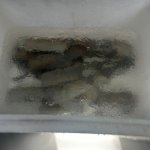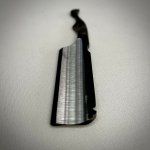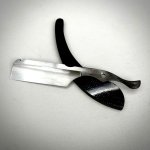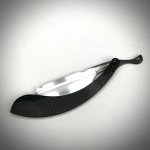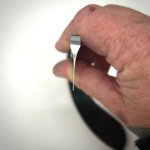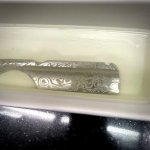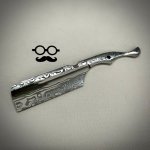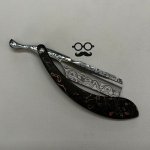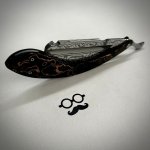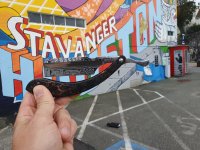The Shaving Cadre
You are using an out of date browser. It may not display this or other websites correctly.
You should upgrade or use an alternative browser.
You should upgrade or use an alternative browser.
WoolfBlades Straight Razor Build and Review
- Thread starter JPO
- Start date
Done. You can contact any of the Concierge staff anytime you need help with a thread.If any moderators are reading this, please add an extra o in ny post.
Just a little information about the steel for those steel nerds out there
The Damasteel® manufacturing process begins with a gas atomization steel making process. In this process, molten steel is forced through a nozzle, creating fine aerosolized powders. These powders are shaped into perfect spheres, ensuring a high level of cleanliness and an even distribution of carbides, which enhance the cutting capabilities of the steel.
After the steel powders are formed, they are collected in a sealed canister. This canister undergoes a process called Hot Isostatic Pressing (HIP), where the powders are compacted and bonded together. The HIP process involves subjecting the canister to high temperature and pressure, resulting in a densified material. As a result of this process, the size of the steel material is reduced by approximately 30%.
What makes Damasteel unique is that it doesn't contain any welds, making it an extremely strong steel. The absence of welds contributes to its structural integrity and durability.
Once the HIP process is complete, the steel undergoes forging and texturing rolling in a specific manner to achieve various patterns. This phase of pattern creation is similar in both traditional damascus steel and Damasteel. Damasteel offers a wide variety of patterns, including ladder, rose™ (raindrop), Dense Twist™, and Dden's Eye™. Some of these patterns are exclusive to Damasteel and are trademarked.
Damasteel also produces composite steels. Through the particle metal process, Damasteel ensures that its steel contains fewer impurities and inclusions compared to traditional damascus steel. Additionally, Damasteel incorporates two particle steel alloys: RWL 34 and PMC27 steel. RWL 34, named after the legendary knife maker Robert 'Bob' Loveless, is a Swedish-made knife steel that exhibits properties similar to CPM 154 and ATS 34. The lighter color pattern in the damascus is achieved when the RWL 34 steel is etched. The second steel, PMC27 stainless steel alloy, contributes to the darker pattern bands when etched onto the damascus surface. Both composite steels are manufactured using the particle metal process, resulting in improved toughness and edge retention compared to conventionally made steels.
In summary, Damasteel combines the beauty and artistry of damascus steel with exceptional strength and durability. It offers high-performance damascus and stainless qualities, making it a preferred choice for those seeking these attributes. The distinctive patterning achieved through the HIP process sets Damasteel apart from traditional damascus steel, providing a visually unique appearance. The selection of damascus steel patterns is diverse, catering to individual preferences and tastes.
I find it fascinating that this razor features the Vinland pattern. It's intriguing to note that the name "Vinland" has historical significance in relation to Vikings and their exploration of North America. The first Viking known to have set foot on North American soil referred to the land as Vinland.
Fun fact for me as a Norwegian
The Damasteel® manufacturing process begins with a gas atomization steel making process. In this process, molten steel is forced through a nozzle, creating fine aerosolized powders. These powders are shaped into perfect spheres, ensuring a high level of cleanliness and an even distribution of carbides, which enhance the cutting capabilities of the steel.
After the steel powders are formed, they are collected in a sealed canister. This canister undergoes a process called Hot Isostatic Pressing (HIP), where the powders are compacted and bonded together. The HIP process involves subjecting the canister to high temperature and pressure, resulting in a densified material. As a result of this process, the size of the steel material is reduced by approximately 30%.
What makes Damasteel unique is that it doesn't contain any welds, making it an extremely strong steel. The absence of welds contributes to its structural integrity and durability.
Once the HIP process is complete, the steel undergoes forging and texturing rolling in a specific manner to achieve various patterns. This phase of pattern creation is similar in both traditional damascus steel and Damasteel. Damasteel offers a wide variety of patterns, including ladder, rose™ (raindrop), Dense Twist™, and Dden's Eye™. Some of these patterns are exclusive to Damasteel and are trademarked.
Damasteel also produces composite steels. Through the particle metal process, Damasteel ensures that its steel contains fewer impurities and inclusions compared to traditional damascus steel. Additionally, Damasteel incorporates two particle steel alloys: RWL 34 and PMC27 steel. RWL 34, named after the legendary knife maker Robert 'Bob' Loveless, is a Swedish-made knife steel that exhibits properties similar to CPM 154 and ATS 34. The lighter color pattern in the damascus is achieved when the RWL 34 steel is etched. The second steel, PMC27 stainless steel alloy, contributes to the darker pattern bands when etched onto the damascus surface. Both composite steels are manufactured using the particle metal process, resulting in improved toughness and edge retention compared to conventionally made steels.
In summary, Damasteel combines the beauty and artistry of damascus steel with exceptional strength and durability. It offers high-performance damascus and stainless qualities, making it a preferred choice for those seeking these attributes. The distinctive patterning achieved through the HIP process sets Damasteel apart from traditional damascus steel, providing a visually unique appearance. The selection of damascus steel patterns is diverse, catering to individual preferences and tastes.
I find it fascinating that this razor features the Vinland pattern. It's intriguing to note that the name "Vinland" has historical significance in relation to Vikings and their exploration of North America. The first Viking known to have set foot on North American soil referred to the land as Vinland.
Fun fact for me as a Norwegian
Very nicely done

